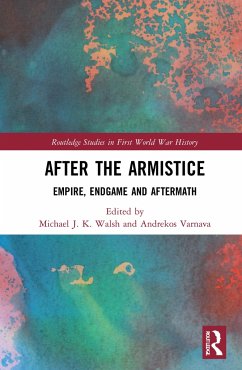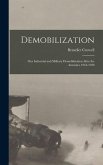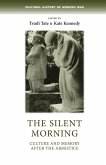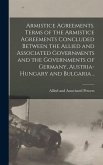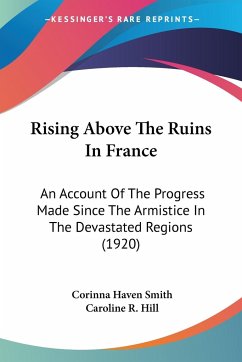After the Armistice
Empire, Endgame and Aftermath
Herausgeber: Walsh, Michael J. K.; Varnava, Andrekos
After the Armistice
Empire, Endgame and Aftermath
Herausgeber: Walsh, Michael J. K.; Varnava, Andrekos
- Broschiertes Buch
- Merkliste
- Auf die Merkliste
- Bewerten Bewerten
- Teilen
- Produkt teilen
- Produkterinnerung
- Produkterinnerung
This volume investigates the post-Armistice Empire across a spectrum of disciplines, geographies and chronologies to compliment extant academic debates on the legacies of colonialism and nationalism.
Andere Kunden interessierten sich auch für
![The Story of the Great War, Volume 8 - Victory with the Allies, Armistice ¿ Peace Congress, Canada's War Organizations and Vast War Industries, Canadian Battles Overseas (WWI Centenary Series) The Story of the Great War, Volume 8 - Victory with the Allies, Armistice ¿ Peace Congress, Canada's War Organizations and Vast War Industries, Canadian Battles Overseas (WWI Centenary Series)]() Allen L. ChurchillThe Story of the Great War, Volume 8 - Victory with the Allies, Armistice ¿ Peace Congress, Canada's War Organizations and Vast War Industries, Canadian Battles Overseas (WWI Centenary Series)43,99 €
Allen L. ChurchillThe Story of the Great War, Volume 8 - Victory with the Allies, Armistice ¿ Peace Congress, Canada's War Organizations and Vast War Industries, Canadian Battles Overseas (WWI Centenary Series)43,99 €![Demobilization: Our Industrial and Military Demobilization After the Armistice 1918-1920 Demobilization: Our Industrial and Military Demobilization After the Armistice 1918-1920]() Benedict CrowellDemobilization: Our Industrial and Military Demobilization After the Armistice 1918-192038,99 €
Benedict CrowellDemobilization: Our Industrial and Military Demobilization After the Armistice 1918-192038,99 €![The silent morning The silent morning]() The silent morning32,99 €
The silent morning32,99 €![Armistice Agreements. Terms of the Armistice Agreements Concluded Between the Allied and Associated Governments and the Governments of Germany, Austria-Hungary and Bulgaria .. Armistice Agreements. Terms of the Armistice Agreements Concluded Between the Allied and Associated Governments and the Governments of Germany, Austria-Hungary and Bulgaria ..]() Armistice Agreements. Terms of the Armistice Agreements Concluded Between the Allied and Associated Governments and the Governments of Germany, Austria-Hungary and Bulgaria ..27,99 €
Armistice Agreements. Terms of the Armistice Agreements Concluded Between the Allied and Associated Governments and the Governments of Germany, Austria-Hungary and Bulgaria ..27,99 €![Returned With a Creed Returned With a Creed]() Ruth JamesReturned With a Creed49,99 €
Ruth JamesReturned With a Creed49,99 €![Rising Above The Ruins In France Rising Above The Ruins In France]() Corinna Haven SmithRising Above The Ruins In France33,99 €
Corinna Haven SmithRising Above The Ruins In France33,99 €![The First World War Peace Settlements, 1919-1925 The First World War Peace Settlements, 1919-1925]() Erik GoldsteinThe First World War Peace Settlements, 1919-192553,99 €
Erik GoldsteinThe First World War Peace Settlements, 1919-192553,99 €-
-
-
This volume investigates the post-Armistice Empire across a spectrum of disciplines, geographies and chronologies to compliment extant academic debates on the legacies of colonialism and nationalism.
Hinweis: Dieser Artikel kann nur an eine deutsche Lieferadresse ausgeliefert werden.
Hinweis: Dieser Artikel kann nur an eine deutsche Lieferadresse ausgeliefert werden.
Produktdetails
- Produktdetails
- Verlag: Routledge
- Seitenzahl: 302
- Erscheinungstermin: 31. Mai 2023
- Englisch
- Abmessung: 234mm x 156mm x 16mm
- Gewicht: 462g
- ISBN-13: 9781032005638
- ISBN-10: 1032005637
- Artikelnr.: 67823325
- Herstellerkennzeichnung
- Libri GmbH
- Europaallee 1
- 36244 Bad Hersfeld
- gpsr@libri.de
- Verlag: Routledge
- Seitenzahl: 302
- Erscheinungstermin: 31. Mai 2023
- Englisch
- Abmessung: 234mm x 156mm x 16mm
- Gewicht: 462g
- ISBN-13: 9781032005638
- ISBN-10: 1032005637
- Artikelnr.: 67823325
- Herstellerkennzeichnung
- Libri GmbH
- Europaallee 1
- 36244 Bad Hersfeld
- gpsr@libri.de
Michael J. K. Walsh is Chair of the School of Art, Design and Media at Nanyang Technological University Singapore and is Professor of Art History. He has published widely on culture at the time of the Great War and has a particular interest in painting and music. Andrekos Varnava, FRHistS, is an Associate Professor in History at Flinders University, South Australia, and an Honorary Professor in History at De Montfort University, Leicester. He is the author of four monographs, eight edited volumes and 50 peer-reviewed journal articles and book chapters.
Introduction: After the Armistice: Empire, Endgame and Aftermath 1. '
Britannia Pacificatrix': Re-Imagining a post-Armistice Empire Part 1:
Imperial Endgames 2. 'Imperial Coercion in Ireland and India 1919-1921:
Insights for Irish Australians.' 3. 'Germans on the British Imperial
Peripheries: Lagos and Tonga 1914-1919' 4.'Imperial Masculinity and Racial
Pacification: "Martial Bengalis" in the Great War' 5. 'Society and Identity
in the former Ottoman World: Encounters between Cypriots and Armenians of
the Légion d'Orient in Cyprus in 1917-1918' 6. 'Mary Booth's Nationalism at
the end of the Great War' 7. '"The True Story of Ah Q": British decline,
American power, the rise of Chinese nationalism 1918-1923 and reflexive
contemporary centenary commemoration in China' 8. 'An Empire man on the
road to Dominion independence: Robert Randolph Garran's experience of the
Armistice "blunder" and its aftermath' Part 2: Cultural Aftermaths 9. 'The
threshold of the British Empire': Accommodation, coercion and the
commemoration of a national Australian narrative of war at an imperial site
of memory 10. 'A deathless monument of valour': The national
memorialisation of Anzacs as ancient Greek citizen-soldiers from the war's
aftermath to the centenary Dawn Service at Gallipoli 11. 'If Not In This
World': memorialising the personal narrative of micro-history with music
12. 'Pleasant Remembrances and Foreboding Futures': Glorifying
Representations of Empire and their Opposition within Britain's National
Cinema during the 1930s 13. 'Reconciliation through Commemoration':
Ireland, Empire, and the 1987 Enniskillen Armistice Day Bombing 14. 'We're
here because we're here': The emotive power of the dominant cultural
imaginary of the Tommy in post-Brexit Britain Part 3: Coda 15. 'The Hall of
Remembrance'
Britannia Pacificatrix': Re-Imagining a post-Armistice Empire Part 1:
Imperial Endgames 2. 'Imperial Coercion in Ireland and India 1919-1921:
Insights for Irish Australians.' 3. 'Germans on the British Imperial
Peripheries: Lagos and Tonga 1914-1919' 4.'Imperial Masculinity and Racial
Pacification: "Martial Bengalis" in the Great War' 5. 'Society and Identity
in the former Ottoman World: Encounters between Cypriots and Armenians of
the Légion d'Orient in Cyprus in 1917-1918' 6. 'Mary Booth's Nationalism at
the end of the Great War' 7. '"The True Story of Ah Q": British decline,
American power, the rise of Chinese nationalism 1918-1923 and reflexive
contemporary centenary commemoration in China' 8. 'An Empire man on the
road to Dominion independence: Robert Randolph Garran's experience of the
Armistice "blunder" and its aftermath' Part 2: Cultural Aftermaths 9. 'The
threshold of the British Empire': Accommodation, coercion and the
commemoration of a national Australian narrative of war at an imperial site
of memory 10. 'A deathless monument of valour': The national
memorialisation of Anzacs as ancient Greek citizen-soldiers from the war's
aftermath to the centenary Dawn Service at Gallipoli 11. 'If Not In This
World': memorialising the personal narrative of micro-history with music
12. 'Pleasant Remembrances and Foreboding Futures': Glorifying
Representations of Empire and their Opposition within Britain's National
Cinema during the 1930s 13. 'Reconciliation through Commemoration':
Ireland, Empire, and the 1987 Enniskillen Armistice Day Bombing 14. 'We're
here because we're here': The emotive power of the dominant cultural
imaginary of the Tommy in post-Brexit Britain Part 3: Coda 15. 'The Hall of
Remembrance'
Introduction: After the Armistice: Empire, Endgame and Aftermath 1. '
Britannia Pacificatrix': Re-Imagining a post-Armistice Empire Part 1:
Imperial Endgames 2. 'Imperial Coercion in Ireland and India 1919-1921:
Insights for Irish Australians.' 3. 'Germans on the British Imperial
Peripheries: Lagos and Tonga 1914-1919' 4.'Imperial Masculinity and Racial
Pacification: "Martial Bengalis" in the Great War' 5. 'Society and Identity
in the former Ottoman World: Encounters between Cypriots and Armenians of
the Légion d'Orient in Cyprus in 1917-1918' 6. 'Mary Booth's Nationalism at
the end of the Great War' 7. '"The True Story of Ah Q": British decline,
American power, the rise of Chinese nationalism 1918-1923 and reflexive
contemporary centenary commemoration in China' 8. 'An Empire man on the
road to Dominion independence: Robert Randolph Garran's experience of the
Armistice "blunder" and its aftermath' Part 2: Cultural Aftermaths 9. 'The
threshold of the British Empire': Accommodation, coercion and the
commemoration of a national Australian narrative of war at an imperial site
of memory 10. 'A deathless monument of valour': The national
memorialisation of Anzacs as ancient Greek citizen-soldiers from the war's
aftermath to the centenary Dawn Service at Gallipoli 11. 'If Not In This
World': memorialising the personal narrative of micro-history with music
12. 'Pleasant Remembrances and Foreboding Futures': Glorifying
Representations of Empire and their Opposition within Britain's National
Cinema during the 1930s 13. 'Reconciliation through Commemoration':
Ireland, Empire, and the 1987 Enniskillen Armistice Day Bombing 14. 'We're
here because we're here': The emotive power of the dominant cultural
imaginary of the Tommy in post-Brexit Britain Part 3: Coda 15. 'The Hall of
Remembrance'
Britannia Pacificatrix': Re-Imagining a post-Armistice Empire Part 1:
Imperial Endgames 2. 'Imperial Coercion in Ireland and India 1919-1921:
Insights for Irish Australians.' 3. 'Germans on the British Imperial
Peripheries: Lagos and Tonga 1914-1919' 4.'Imperial Masculinity and Racial
Pacification: "Martial Bengalis" in the Great War' 5. 'Society and Identity
in the former Ottoman World: Encounters between Cypriots and Armenians of
the Légion d'Orient in Cyprus in 1917-1918' 6. 'Mary Booth's Nationalism at
the end of the Great War' 7. '"The True Story of Ah Q": British decline,
American power, the rise of Chinese nationalism 1918-1923 and reflexive
contemporary centenary commemoration in China' 8. 'An Empire man on the
road to Dominion independence: Robert Randolph Garran's experience of the
Armistice "blunder" and its aftermath' Part 2: Cultural Aftermaths 9. 'The
threshold of the British Empire': Accommodation, coercion and the
commemoration of a national Australian narrative of war at an imperial site
of memory 10. 'A deathless monument of valour': The national
memorialisation of Anzacs as ancient Greek citizen-soldiers from the war's
aftermath to the centenary Dawn Service at Gallipoli 11. 'If Not In This
World': memorialising the personal narrative of micro-history with music
12. 'Pleasant Remembrances and Foreboding Futures': Glorifying
Representations of Empire and their Opposition within Britain's National
Cinema during the 1930s 13. 'Reconciliation through Commemoration':
Ireland, Empire, and the 1987 Enniskillen Armistice Day Bombing 14. 'We're
here because we're here': The emotive power of the dominant cultural
imaginary of the Tommy in post-Brexit Britain Part 3: Coda 15. 'The Hall of
Remembrance'

